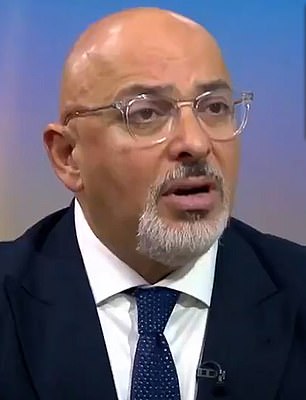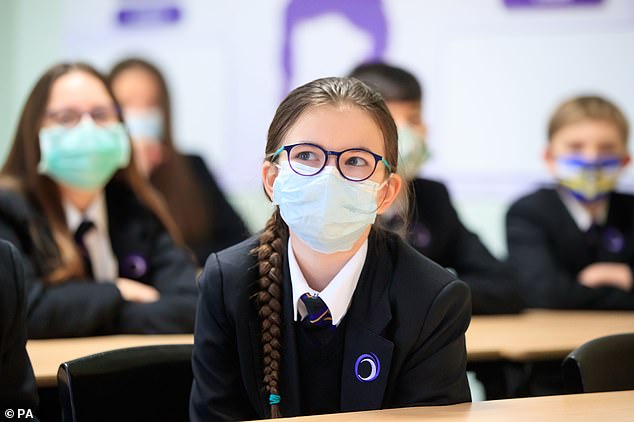
Education Secretary Nadhim Zahawi said contingency plans ‘absolutely’ includes bribing back face coverings in classrooms
Face masks could be brought back in schools to stem the spread of the coronavirus this winter, the Education Secretary admitted today.
Guidance saying all children should wear coverings in classrooms and corridors was dropped in mid-May as part of No10’s drive to learn to live with the virus.
But ministers have made contingency plans in the event of a rapid surge in cases among pupils.
Nadhim Zahawi defended the potential measures, which includes coverings, increased pupil and staff testing and shielding vulnerable pupils.
He insisted his priority was to ‘protect education’ and keep schools open.
Meanwhile, Mr Zahawi also said he doesn’t want to bring back bubbles, which saw entire classes and year groups sent home if one child tested positive.
Original coronavirus-fighting measures deployed in English schools contributed to 1.1million children being stuck at home during the most disruptive days of the Covid pandemic.
Ministers said dropping face masks would improve interactions between teachers and pupils, while ending bubbles would ease disruptions to education.

The mandatory wearing of face coverings in schools and colleges was scrapped in May. Some were concerned that masks interrupted learning, but others warned they were necessary to suppress outbreaks. Pictured: children wearing facemasks at Outwood Academy in Doncaster in Yorkshire in March
Government guidance published in August said some measures could be brought back to manage local outbreaks, respond to variants of concern or prevent the NHS from becoming overwhelmed.
Local health chiefs can implement the measures in the response to outbreaks.
Face masks are already in use at schools in parts of the South West, Cumbria and Northamptonshire.
But current restrictions only require school children to test themselves for the virus twice a week using a lateral flow device.
UK’s daily Covid cases RISE for first time in a week: 9% jump sees 39,851 infections
Britain’s downturn in Covid cases may have come to an end, official figures suggested yesterday as daily infections rose for the first time in a week.
Department of Health bosses posted 39,851 new positive tests today, up 8.5 per cent on last Wednesday’s count of 36,722. It is the largest daily toll since September 6 (41,192).
Hospitalisations also increased 1.1 per cent to 666 on Saturday, the latest date data is available for. It was the first time in 20 days the number of daily admissions had increased week-on-week.
But the number of people dying within 28 days of a positive test has continued to fall, with 143 fatalities recorded today. Deaths were down 4.7 per cent on the 150 recorded last Wednesday, marking the twelfth day in a row the number of victims fell week-on-week.
It comes after separate official figures today revealed nearly a fifth of people in Blackburn have tested positive for Covid since the pandemic began.
The Lancashire authority has been the worst hit area in the UK, recording 12 times more cases per population size than the least affected parts of the UK.
Department of Health data shows around 19,000 per 100,000 people in Blackburn have had the virus since March 2020, compared to just 1,500 in the Orkney Islands in Scotland.
Advertisement
Cases have exploded to record-highs in children since schools went back, with 1.5 per cent of youngsters aged 10 to 14 testing positive in the week ending October 1.
However, Government data suggests infections have started to fall among children over the most recent four days.
Speaking to Sky News, Mr Zahawi said: ‘Thanks to the brilliant teachers and support staff and parents and children — 99 per cent of schools are open.
‘Attendance has gone up, the last set of figures I looked at was about 90 per cent, which obviously will fluctuate depending on infection rates.
‘But my priority is to protect education, keep those schools open.’
But Mr Zahawi revealed he was not looking to return to the bubble system to do so, ‘because actually, you saw the fall off in attendance which really does harm mental wellbeing, mental health of children’.
He did not, however, rule out the return of the wearing of masks in the classroom in England.
He said: ‘We’ve got a contingency plan, as you would expect me to do… it contains lots of contingencies, including masks, absolutely.’
Mr Zahawi also confirmed 300,000 carbon dioxide monitors would be in schools by November after supply problems slowed the roll out.
The machines work by identifying how much CO2 is in the air, with higher levels indicating that there is poor ventilation in a space, which could encourage the virus to spread.
School staff can then take action, such as opening doors and windows, to increase ventilation.
Mr Zahawi said: ‘They’re going out by the end of this month. We will have the real uplift in those numbers into schools, really important.
‘We’re also looking at ventilation, and how we make sure that schools have access to ventilation.’
As well as the machines, ministers are relying on Covid jabs for 12 to 15-year-olds to quell an expected fourth wave this winter.
Mr Zahawi, previously No10’s vaccines minister, told Times Radio: ‘I haven’t seen the take-up rates and I am due to have a meeting with my old team.
‘So I’ll have a look at the data but the good news at universities is take-up is touching 90 per cent.’
‘There’s a lag because obviously you’ve got to get consent letters out, they’ve got to come back and then the school, with the school-age immunisation clinicians, decide as to when they’ve got enough students (and) parents have consented, that they can actually vaccinate.’
Source link : https://www.dailymail.co.uk/news/article-10068073/Nadhim-Zahawi-admits-MASKS-return-schools-thwart-Covid-winter.html











